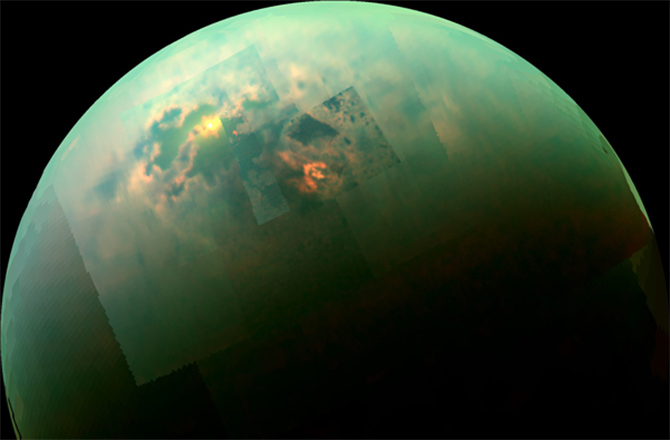
Cassini has spotted sun glint before on Titan's surface, but this is the first set of observations (stitched together as a mosaic) where the boundaries of the seas and the sunlight glint are visible in the same view.
As Titan's surface is so cold, water cannot exist in a liquid state. Instead, the world cycles liquid methane (a substance that has a lower freezing point than water) from Titan's "great lakes", into the atmosphere as vapor, which condenses as clouds, raining methane back down onto the hydrocarbon surface. Much like Earth's water cycle, Titan's methane cycle creates rivers, deltas, valleys and large masses of liquid methane as observed here.
The sea glinting in sunlight is Kraken Mare, Titan's largest body of liquid. Surrounding Kraken Mare is a 'bathtub ring' - an old coastline that suggests the sea was at a higher level than it is now.
This observation was captured by Cassini's Visible and Infrared Mapping Spectrometer (VIMS) on Aug. 21.
Comment: The colorized mosaic from the visual and infrared mapping spectrometer, which maps infrared colors onto the visible-color spectrum, reveals differences in the composition of material around the lakes. The data suggest parts of Titan's lakes and seas may have evaporated and left behind the Titan equivalent of Earth's salt flats. The evaporated material is thought to be organic chemicals originally from Titan's haze particles that once dissolved in liquid methane. They appear orange in this image against the greenish backdrop of Titan's typical bedrock of water ice.
The bright area suggests that the surface here is unique from the rest of Titan, which might explain why almost all of the lakes are found in this region. Titan's lakes have very distinctive shapes -- rounded cookie-cutter silhouettes and steep sides -- and a variety of formation mechanisms have been proposed. The explanations range from the collapse of land after a volcanic eruption to karst terrain, where liquids dissolve soluble bedrock. Karst terrains on Earth can create spectacular topography such as the Carlsbad Caverns in New Mexico. -JPL
Launched in 1997, Cassini has been exploring the Saturn system since 2004. A full Saturn year is 30 years, and Cassini has been able to observe nearly a third of a Saturn year. In that time, Saturn and its moons have seen the seasons change from northern winter to northern summer.



Reader Comments
to our Newsletter